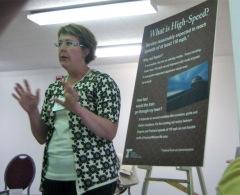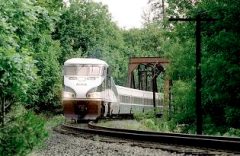
(Photo: Daniel Ronan)
The Obama Administration recently green-lighted money for development of a rail corridor between Eugene and Portland and the Oregon Department of Transportation (ODOT) is hosting a series of open houses to discuss the project.
I recently spoke with ODOT’s rail program study director Betsy Imholt and attended the open house in Eugene yesterday to learn more about how bikes might (or might not) fit into ODOT’s passenger rail plans.
“Now we have something to look for that is a little bolder than incremental improvements.”
— Betsy Imholt, ODOT
Imholt said that despite all the buzz about rail, it’s not new to ODOT. “A lot of people think that this is new, but we’ve been planning since the 1960s.” But now, with recent interest and investment from the US DOT, she added that, “we have something to look for that is a little bolder than incremental improvements.”
Imholt stressed that citizen involvement in the open houses and participation in the online survey is critical in shaping goals for the future high-speed rail in Oregon. “We have taken the railroad knowledge that we have and set draft service goals; we really don’t know if those are too ambitious or not ambitious enough,” Imholt says.

see a bike trail.
(Photo: ODOT)
Draft goals for the rail corridor include: reducing travel time from Eugene to Portland from two hours and thirty-five minutes to two hours, increasing on-time performance from 68 to 95 percent and increasing total daily round trips from two to six. Imholt stresses that these goals are in the draft phase. “The open houses and the survey are intended to give us feedback on these goals.” The goals will in turn shape the alignment of rail service in the Willamette Valley.
With regard to rail alignments, Imholt mentions that some citizens have advocated for a high-speed rail alignment along parts of I-5:
“Transportation connections, multimodal systems, and livability are important concepts, and an I-5 alignment will have a harder time reflecting a lot of these challenges. One benefit is the potential of faster speeds, however, the faster you go the less you stop, so informing the public of these trade offs is key.”
Also, Imholt added that an I-5 alignment could potentially limit bicycle and pedestrian connections in town centers, which highlights the importance of broad public participation.
As a sign of ODOT’s commitment to passenger rail, this past spring the agency used surplus funds from low bids on highway construction projects to purchase two new Talgo passenger trains. The trains will be equipped with baggage cars with a carrying capacity of up to 15 additional bikes per train.
Imholt says that the input from the survey responses received included many comments about bikes, suggesting that more comments would play a larger role in how bikes are considered in future service goals.
Open houses are being held across the Willamette Valley. Portland’s open house tonight from 4:30 to 6:30 at 123 NW Flanders in downtown Portland. Learn more at ODOT’s Passenger Rail website.
— For more on Obama’s high speed rail plans and how bikes might factor into them, read our story from February.

